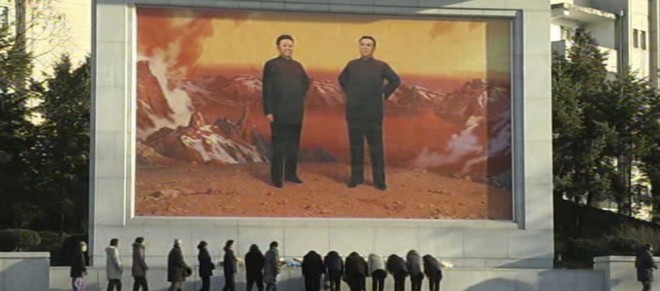North Korea’s enduring nightmare
Kim Jong Il’s death may allow Koreans to stir from the nightmare, but it won’t end it
In this image made from Associated Press Television News, North Koreans gather to mourn the death of North Korean leader Kim Jong Il in front of a mural depicting Kim Jong Il and his father Kim Sung Il in Pyongyang, Monday, Dec. 19, 2011. Kim’s death after 17 years as leader was announced Monday by state television two days after he died. North Korea’s news agency reported that he had died at 8:30 a.m. Saturday after having a heart attack on a train, adding that he had been treated for cardiac and cerebrovascular diseases for a long time. He was 69. (AP Photo/APTN) TV OUT
Share
 Kim Jong Il’s death this weekend was something Western politicians both desired and feared. The North Korean dictator was an implacable enemy of the West, who pursued and obtained nuclear weapons, and was willing to give or sell the technology and know-how necessary for others to do the same. In 2007, Israel bombed what’s believed to have been a Syrian nuclear reactor that was modeled on North Korean designs.
Kim Jong Il’s death this weekend was something Western politicians both desired and feared. The North Korean dictator was an implacable enemy of the West, who pursued and obtained nuclear weapons, and was willing to give or sell the technology and know-how necessary for others to do the same. In 2007, Israel bombed what’s believed to have been a Syrian nuclear reactor that was modeled on North Korean designs.
Under Kim’s leadership, North Korea’s belligerence toward South Korea continued unabated. Only last year, the North torpedoed and sunk a South Korean navy ship, killing 46 sailors on boards. Nuclear weapons aside, there are enough conventional artillery and rockets aimed at the South that Seoul would be flattened within hours of all-out war.
But Kim’s death is potentially dangerous, too, as it may destabilize an already erratic regime. Kim’s chosen heir, his son Kim Jong Un, has already been dubbed the “Great Successor.” He is in fact a twenty-something enigma with virtually no political or military experience. The succession may not be smooth, and a power struggle may lead to the state’s collapse, resulting in millions of refugees flooding into China and South Korea, potentially unguarded nuclear sites, and the possibility of a confrontation between China and the United States over the region’s future. While Kim’s death ultimately provides a welcome opportunity for North Korea to at least stir from its nightmare, there is also the risk that in the immediate future he will cause more trouble dead than he did alive.
Kim Jong Il will likely be remembered most for his nuclear posturing, threats, and the occasional violence North Korea meted out against the South on his watch. But these transgressions are almost forgettable compared to what he inflicted on his fellow North Koreans.
In a just world, the strange and chubby son of Kim Il Sung, North Korea’s founding dictator and “Eternal President,” would not have been in charge of a poultry farm, let alone a country. Stalin allegedly described the death of one man as a tragedy, and that of thousands as a statistic. Kim’s cruelty covered both extremes, ruining individual lives while causing uncountable deaths. He had a South Korean movie director and his wife kidnapped and brought to the North for his amusement. Some two million North Koreans starved to death in a famine resulting from his economic policies. Thousands more suffer in concentration camps, often for the crime of trying to escape. Widespread starvation and malnutrition means North Koreans are universally shorter than their kin to the south.
So what are we to make of the scenes of abject grief beamed today out of the normally shuttered country? Much is no doubt fabricated. (Pity the newsreader who doesn’t break down when announcing Kim’s death.) But much is also probably genuine. It’s unlikely a state has ever been so smashed and reworked into such a total and impenetrable personality cult.
Literary critic B.R. Meyers took on the thankless task of sifting through North Korea’s vast output of propaganda, from children’s books to posters. The resulting book, The Cleanest Race: How North Koreans See Themselves, concludes that Pyongyang’s official ideology more closely mimics racist Japanese fascism from the 1930s than the Stalinist Communism to which it is more often compared.
North Koreas are told they are innocent children in a racially pure enclave who need the protection of a great leader to shelter them from the predatory mongrels outside. But in state propaganda, Kim, unlike other tyrants throughout history, is not depicted as a square-jawed, well-muscled hero. His features are rounded and soft, even feminine. He is a parent to children not ready to face the world on their own. And now he’s gone. “What are we supposed to do?” one mourning North Korean asked a reporter.
Or it might be that loving the bully who starves and imprisons you in a place like North Korea is all you can do to stay sane. “A North Korean citizen who decided that it was all a lie and a waste would have to face the fact that his life had been a lie and a waste also,” Christopher Hitchens wrote after a visit to North Korea a decade ago.
Kim Jong Il’s life was a lie and a waste. North Korea’s next chapter may be equally grim, but at least this one is over.